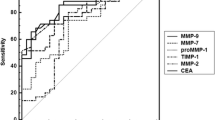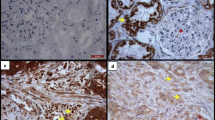Abstract
Background and aims
The aim of this study was to determine the prognostic role of matrix metalloproteinases in rectal cancer.
Materials and methods
Formalin-fixed and paraffin-embedded tissue sections of 94 rectal carcinomas were used for the immunohistochemical analysis of matrix metalloproteinases (MMP)-2, MMP-7, MT1-MMP, and tissue inhibitor of metalloproteinases (TIMP)-2. Inclusion criteria were sporadic rectal adenocarcinoma resected curatively (including total mesorectal excision), adjuvant radiochemotherapy in UICC stages II and III, and complete intra-institutional follow-up. Results of immunohistochemistry were correlated with clinical and histopathologic data from the prospective rectal cancer registry and prognosis. End points of the prognostic analysis were tumor progression caused by local and/or distant recurrence and 5-year survival (disease-free and overall). To assess prognostic significance, statistics included univariate and multivariate analysis (p<0.05 statistically significant).
Results
Of the 94 rectal carcinomas, 35% (33/94) showed an epithelial MMP-2 expression, 77% (72/94) were MMP-2 positive in the stroma. Fifty-four percent (51/94) were MMP-7 positive, and 47% (46/94) were positive for both MT1-MMP and TIMP-2. The stromal MMP-2 staining pattern was correlated with the depth of invasion (pT status, p=0.006) with MMP-7 (p=0.016) and TIMP-2 expression (p=0.036). Positive expression of MMP-2 in tumor epithelium was correlated with MMP-7 (p=0.027), MT1-MMP (p=0.036), and TIMP-2 expression (p<0.0001). A positive staining pattern of MMP-7 was significantly correlated with depth of invasion and TIMP-2 (p<0.01). The positive staining pattern of MT1-MMP was correlated with epithelial MMP-2 (p=0.036), MMP-7 (p=0.004), and TIMP-2 expression (p=0.002). TIMP-2 immunoreactivity correlated with depth of invasion (p=0.013), epithelial MMP-2 (p<0.001), stromal MMP-2 (p=0.036), MMP-7 (p<0.001), and MT1-MMP (p=0.002). Neither pattern correlated with age, gender, tumor stage (UICC), grading, preoperative serum carcinoembryonic antigen (CEA) level, or nodal status (p>0.05). Within a mean follow-up of 46 months, tumor progression, caused by either local recurrence or distant metastasis, occurred in 14 patients (15.4%). There was no significant association between the MMP expression and the incidence of local and/or distant recurrence. In terms of survival, preoperative CEA level (disease-free 5-year survival 46% with increased CEA vs 70% with normal CEA, p=0.01; overall 5-year survival 43 vs 74%, p<0.01) and UICC stage were the only factors to be significantly related to 5-year survival by univariate analysis, whereas the metalloproteinases failed to show a significant association. In multivariate analysis, CEA and UICC stage were not identified as independent factors predictive of survival.
Conclusion
MMP-2, MMP-7, MT1-MMP, and TIMP-2 do not appear to be significant predictors of prognosis in a homogenous collective of curatively resected rectal adenocarcinomas.


Similar content being viewed by others
References
Basset P, Okada A, Chenard M-P, Kannan R, Stoll I, Anglard P, Bellocq J-P, Rio M-C (1997) Matrix metalloproteinases as stromal effectors of human carcinoma progression: therapeutical implications. Matrix Biol 15:535–541
Westermarck J, Kahari VM (1999) Regulation of matrix metalloproteinase expression in tumor invasion. FASEB J 13:781–792
Bruch HP, Schwandner O, Keller R, Farke S, Schiedeck THK (2003) Surgical therapy for rectal cancer. Chirurg 74:905–914
Bruch HP, Schwandner O, Schiedeck THK, Roblick UJ (1999) Actual standards and controversies on operative technique and lymph-node dissection in colorectal cancer. Langenbecks Arch Surg 384:167–175
Bruch HP, Schwandner O (2002) Totale mesorektale Exzision beim Rektumkarzinom: Das Dissektionsprinzip ohne kontrollierte Daten. Viszeralchirurgie 37:6–11
Wexner SD, Rotholtz NA (2000) Surgeon-influenced variables in resectional rectal cancer surgery. Dis Colon Rectum 43:1606–1627
Hermanek P (1999) Impact of surgeon’s technique on outcome after treatment of rectal carcinoma. Dis Colon Rectum 42:559–562
Köckerling F, Reymond MA, Altendorf-Hofmann A, Dworak O, Hohenberger W (1998) Influence of surgery on metachronous distant metastases and survival in rectal cancer. J Clin Oncol 16:324–329
Talvensaari-Mattila A, Paakko P, Hoyhtya M, Blanco-Sequeiros G, Turpeenniemi-Hujanen T (1998) Matrix metalloproteinase-2 immunoreactive protein: a marker of aggressiveness in breast carcinoma. Cancer 83:1153–1162
Westerlund A, Apaja-Sarkkinen M, Hoyhtya M, Puistola U, Turpeenniemi-Hujanen T (1999) Gelatinase A-immunoreactive protein in ovarian lesions—prognostic value in epithelial ovarian cancer. Gynecol Oncol 75:91–98
Grigioni WF, D’Errico A, Fortunato C, Fiorentino M, Mancini AM, Stetler-Stevenson WG et al (1994) Prognosis of gastric carcinoma revealed by interactions between tumor cells and basement membrane. Mod Pathol 7:220–225
Miyajima Y, Nakano R, Morimatsu M (1995) Analysis of expression of matrix metalloproteinases-2 and -9 in hypopharyngeal squamous cell carcinoma by in situ hybridization. Ann Otol Rhinol Laryngol 104:678–684
Walther MM, Kleiner DE, Lubensky IA, Pozzatti R, Nyguen T, Gnarra JR et al (1997) Progelatinase A mRNA expression in cell lines derived from tumors in patients with metastatic renal cell carcinoma correlates inversely with survival. Urology 50:295–301
D’Errico A, Garbisa S, Liotta LA et al (1991) Augmentation of type IV collagenase, laminin receptor, and Ki-67 proliferation antigen associated with human colon, gastric and breast carcinoma progression. Mod Pathol 4:239–246
Tomita T, Iwata K (1996) Matrix metalloproteinases and tissue inhibitors of metalloproteinases in colonic adenomas-adenocarcinomas. Dis Colon Rectum 39:1255–1264
Kikuchi R, Noguchi T, Takeno S, Kubo N, Uchida Y (2000) Immunohistochemical detection of membrane-type-1-matrixmetalloproteinase in colorectal carcinoma. Br J Cancer 83:215–218
Masaki T, Sugiyama M, Matsuoka H, Abe N, Izumisato Y, Sakamoto A, Atomi Y (2003) Matrix metalloproteinases may contribute compensationally to tumor invasion in T1 colorectal carcinomas. Anticancer Res 23:4169–4173
Sato H, Seiki M (1996) Membrane-type matrix metalloproteinases (MT-MMPs) in tumor metastasis. J Biochem 119:209–215
Ring P, Johansson K, Hoyhtya M, Rubin K, Lindmark G (1997) Expression of tissue inhibitor of metalloproteinase TIMP-2 in human colorectal cancer—a predictor of tumour stage. Br J Cancer 76:805–811
Sis B, Sagol O, Kupelioglu A, Sokmen S, Terzi C, Fuzun M, Ozer E, Bishop P (2004) Prognostic significance of matrix metalloproteinase-2, cathepsin D, and tenascin-C expression in colorectal carcinoma. Pathol Res Pract 200:379–387
Malhotra S, Newman E, Eisenberg D, Scholes J, Wieczorek R, Mignatti P, Shamamian P (2002) Increased membrane type 1 matrix metalloproteinase expression from adenoma to colon cancer: a possible mechanism of neoplastic progression. Dis Colon Rectum 45:537–4322
Bendardaf R, Lamlum H, Vihinen P, Ristamaki R, Laine J, Pyrhonen S (2003) Low collagenase-1 (MMP-1) and MT1-MMP expression levels are favourable survival markers in advanced colorectal carcinoma. Oncology 65:337–346
Joo YE, Seo KS, Kim J, Kim HS, Rew JS, Park CS, Kim SJ (1999) Role of tissue inhibitors of metalloproteinases (TIMPs) in colorectal carcinoma. J Korean Med Sci 14:417–423
Li BH, Zhao P, Liu SZ, Yu YM, Han M, Wen JK (2005) Matrix metalloproteinase-2 and tissue inhibitor of metalloproteinase-2 in colorectal carcinoma invasion and metastasis. World J Gastroenterol 11:3046–3050
Murashige M, Miyahara M, Shiraishi N, Saito T, Kohno K, Kobayashi M (1996) Enhanced expression of tissue inhibitors of metalloproteinases in human colorectal tumors. Jpn J Clin Oncol 26:303–309
Adachi Y, Yamamoto H, Itoh F, Arimura Y, Nishi M, Endo T, Imai K (2001)Clinicopathologic and prognostic significance of matrilysin expression at the invasive front in human colorectal cancers. Int J Cancer 20:290–294
Adachi Y, Yamamoto H, Itoh F, Hinoda Y, Okada Y, Imai K (1999) Contribution of matrilysin (MMP-7) to the metastatic pathway of human colorectal cancers. Gut 45:252–258
Masaki T, Matsuoka H, Sugiyama M, Abe N, Goto A, Sakamoto A, Atomi Y (2001) Matrilysin (MMP-7) as a significant determinant of malignant potential of early invasive colorectal carcinomas. Br J Cancer 84:1317–1321
Luo HZ, Zhou ZG, Yang L, Yu YY, Tian C, Zhou B, Zheng XL, Xia QJ, Li Y, Wang R (2005) Clinicopathologic and prognostic significance of MMP-7 (matrilysin) expression in human rectal cancer. Jpn J Clin Oncol 35:739–744
Roeb E, Arndt M, Jansen B, Schumpelick V, Matern S (2004) Simultaneous determination of matrix metalloproteinases (MMP)-7, MMP-1, -3, and -13 gene expression by multiplex PCR in colorectal carcinomas. Int J Colorectal Dis 19:518–524
Kurokawa S, Arimura Y, Yamamoto H, Adachi Y, Endo T, Sato T, Suga T, Hosokawa M, Shinomura Y, Imai K (2005) Tumour matrilysin expression predicts metastatic potential of stage I (pT1) colon and rectal cancers. Gut 54:1751–1758
Malhotra S, Newman E, Eisenberg D, Scholes J, Wieczorek R, Mignatti P, Shamamian P (2002) Increased membrane type 1 matrix metalloproteinase expression from adenoma to colon cancer: a possible mechanism of neoplastic progression. Dis Colon Rectum 45:537–543
Pesta M, Holubec L Jr, Topolcan O, Cerna M, Rupert K, Holubec LS, Treska V, Kormunda S, Elgrova L, Finek J, Cerny R (2005) Quantitative estimation of matrix metalloproteinases 2 and 7 (MMP-2, MMP-7) and tissue inhibitors of matrix metalloproteinases 1 and 2 (TIMP-1, TIMP-2) in colorectal cancer carcinoma tissue samples. Anticancer Res 25:3387–3391
Langenskiold M, Holmdahl L, Falk P, Ivarsson ML (2005) Increased plasma MMP-2 protein expression in lymph node-positive patients with colorectal cancer. Int J Colorectal Dis 20:245–2552
Acknowledgements
The authors thank Prof. Dr. A.C. Feller, Director of the Institute of Pathology, University Hospital Schleswig-Holstein, Campus Lübeck, for providing tissue blocks. We also thank Mrs. G. Grosser-Pape for technical assistance in the Surgical Research Laboratory, Mrs. C. Killaitis, Department of Surgery, for processing the computerized registry database of rectal cancer, and Dr. H. Paul, Institute of Statistics and Mathematic Economy Research, University of Augsburg, Germany, for independent data analysis and statistical evaluation.
Author information
Authors and Affiliations
Corresponding author
Rights and permissions
About this article
Cite this article
Schwandner, O., Schlamp, A., Broll, R. et al. Clinicopathologic and prognostic significance of matrix metalloproteinases in rectal cancer. Int J Colorectal Dis 22, 127–136 (2007). https://doi.org/10.1007/s00384-006-0173-y
Accepted:
Published:
Issue Date:
DOI: https://doi.org/10.1007/s00384-006-0173-y




